William Saroyan posts a letter (Part 1)
This web page was updated on November 2, 2015
When I purchased a 1962 Irish airmail cover several years ago, on-line, for only 69 cents, I was pleased to be able to add such an attractive but inexpensive item to my collection.
Although only a small image was available when I purchased it, I could tell that the cover was well worth the price. When it arrived in the mail a few days later, I realized that it was a worth much more than I had paid for it, mainly because of who had posted it: the name of American Pulitzer Prize-winning author William Saroyan, one of my favourite authors, was in cursive handwriting in the return address.1
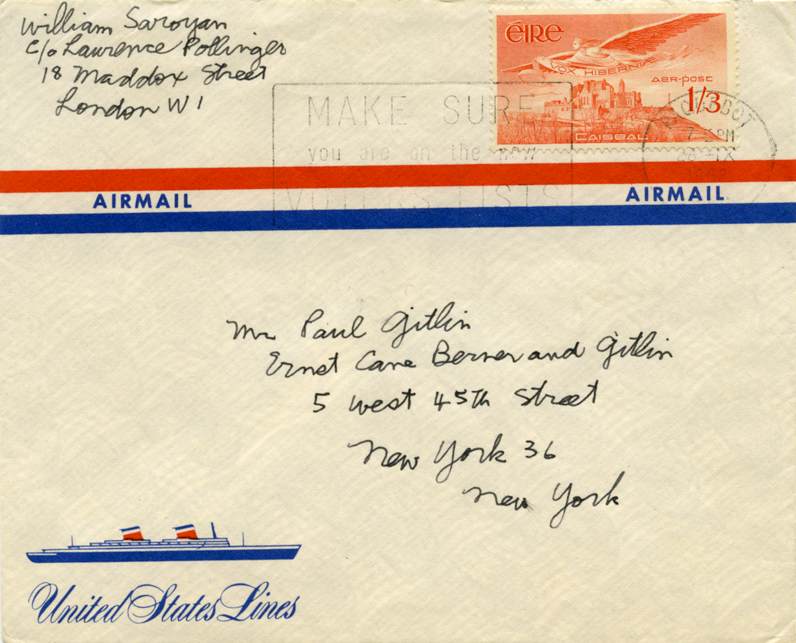
Adding to the philatelic value of the cover is that it’s a paquetbot cover.2 It was posted Sept. 28, 1962 from the United States Lines ocean liner, S.S. America, en route from New York City to Bremerhaven, where it arrived on September 30 following additional stops the at Le Havre and Southampton. America had stopped at Cobh, Ireland, which explains the Irish stamp.3
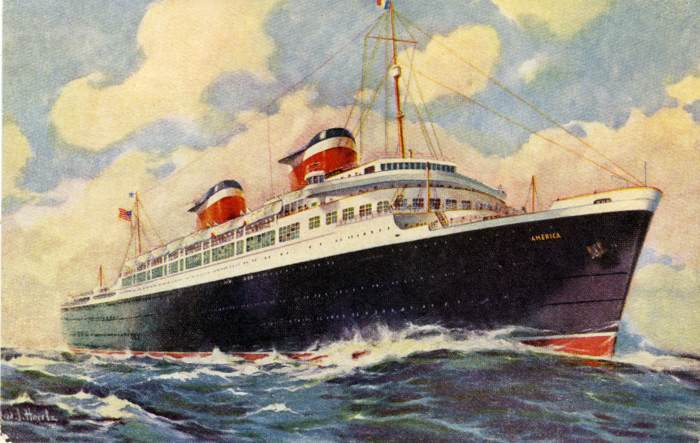
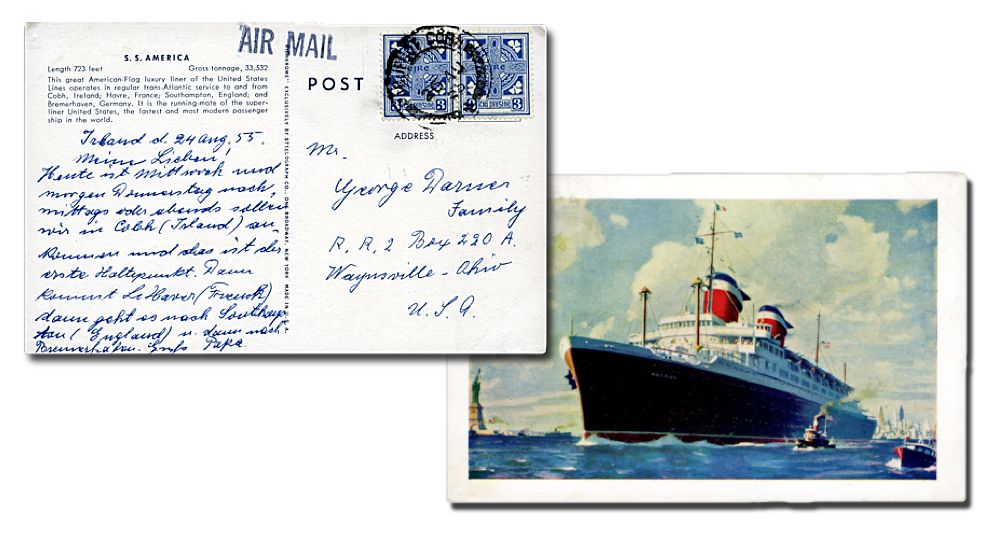
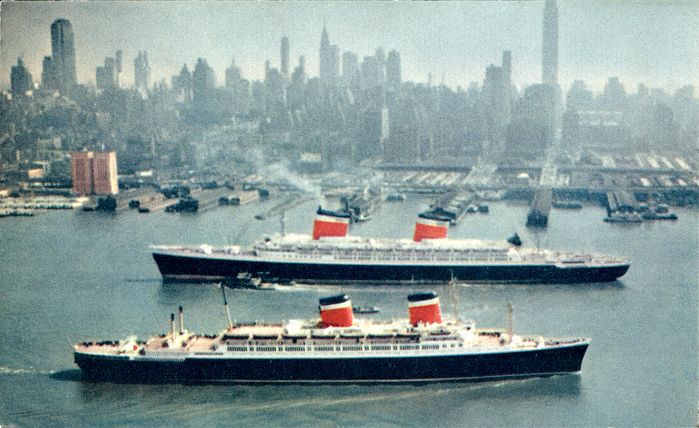

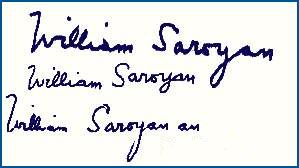
To determine the authenticity of the signature, I turned to the internet, where I found several samples of authentic William Saroyan autographs, shown at the left. Final confirmation came from Saroyan’s son, Aram, who told me that his father had indeed sailed on S.S. America at the time the letter was posted; the recipient, Paul Gitlin (1915-1998), was a lawyer and literary agent who represented such well known authors as Harold Robbins, Cornelius Ryan, and Irving Wallace, and designed the first combined hardcover-paperback deal, selling Robbins’ novel, The Carpetbaggers, to Pocket Books.
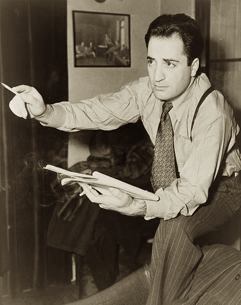
William Saroyan (1908-1981) became a literary spokesperson for America’s Armenian community. Born in Fresno, California, the son of an immigrant, Saroyan was placed in an orphanage in Oakland at the age of four, following the death of his father. In 1921 Saroyan attended technical school to learn to type, but left at the age of fifteen: his mother had shown him some of his father’s writings, and he decided to become a writer. Many of Saroyan’s stories were based on his childhood experiences among the Armenian-American fruit growers of the San Joaquin Valley.
Saroyan is probably best remembered for his 1939 play The Time of Your Life, set in a waterfront saloon in San Francisco. In 1940, it won a Pulitzer Prize, which Saroyan refused on the grounds that commerce should not judge the arts; he did accept the New York Drama Critics’ Circle award. The play was adapted into a 1948 film of the same title film starring James Cagney. In 1943, Saroyan won the Academy Award for “Best Story” for the film adaptation of his novel The Human Comedy.
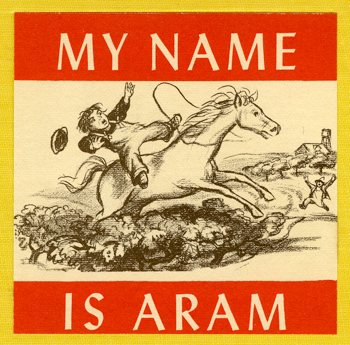
Saroyan’s short-story collection, My Name is Aram, became an international best-seller. It includes “The Summer of the Beautiful White Horse,” one of my favorite short stories, which humorously challenges our notions of right and wrong. The first few paragraphs may entice you to read more. Inexpensive copies of My Name is Aram, in which “The Summer of the Beautiful White Horse” was first published, are available at ABE.com.
Stephen Fry, English comedian, actor, writer, presenter, and activist, describes Saroyan as “…one of the most underrated writers of the [20th] century” who takes his place “naturally alongside Hemingway, Steinbeck and Faulkner.”
My copy of My Name is Aram was published by the Book of the Month Club, and made available to members in December, 1940. Included with the volume was a reprint of a review of the book from the club’s newsletter by Christopher Marley, an American journalist, novelist, essayist, and poet who was also one of the judges of books for the club. The reprint could be “…pasted, if desired, to the flyleaf of the book,” not something you could do with today’s ebooks!
Next, in Part 2: The Soviet Union and the United States co-operate in a rare joint issue of stamps celebrating the life and writing of William Saroyan. The stamps’ designer, Ren Wicks, comments on the challenges he encountered.
-
Saroyan’s London address is given as “c/o Laurence Pollinger / 18 Maddox Street / London W1”. Pollinger was a founding partner in what became one of the world’s largest and most successful of all literary agencies, Pearn, Pollinger and Higham, operating today as Pollinger Ltd. In addition to Saroyan, the company has represented several famous American authors, among them F. Scott Fitzgerald, Dorothy Parker, Carson McCullers, and Erskine Caldwell, and the equally well-known British writers Graham Greene, H.E. Bates, D.H. Lawrence, John Wyndham, and John Masters. ↩︎
-
The Paquetbot cancellation on the Saroyan cover indicates that it was posted aboard a ship without an official post office. The French term Paquebot (usually capitalized or in all capital letters and appearing within the cancellation or as a handstamp impression) means “packet boat” and identifies an item posted on a ship. ↩︎
-
Cobh, Ireland, known from 1850 until the late 1920s as Queenstown, is a tourist seaport town on the south side of Great Island in Cork Harbour and is home to Ireland's only dedicated cruise terminal. Tourism in the area draws on the maritime and emigration legacy of the town; Cobh was the last port of call for RMS Titanic before it sank in the North Atlantic after striking an iceberg. ↩︎